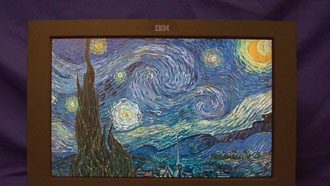Display on display

This year's Society for Information Display (SID) convention was a showcase for makers of display devices of every ilk. Exhibitors at SID are the people who build display devices, not the whole monitor or TV set.
With the public reluctant to pay much for DTV and HDTV receivers, SID was a good place to look for technological trends that could cut the costs of delivering quality pictures to American homes.
The different types of displays can be broken down into three major categories: transmissive, reflective and emissive.
Although all these display devices achieve the end result of producing a viewable picture, it is important to note there are distinct differences. The transmissive display, for example, modulates a light source similar to the displays used on today's laptop computers. The reflective display device uses a mirrored surface that reflects light out to the viewer similar to the digital micro-mirror device (DMD) and the emissive display is a flat-panel display that uses electrical excitation of chemicals, such as the organic light-emitting diode (OLED).
Of particular interest in the transmissive display family was a device shown by IBM called “Bertha.” Bertha offers an extremely high pixel density (204 pixels per inch) and pixel count, or format (3840×2400), which works out to a display of more than nine million pixels. In other words, Bertha has about twice the linear pixel density (204ppi) of typical displays in the marketplace today (approx. 100ppi) or four times the area density.
The monitor has a 16×10 aspect ratio and measure only 22 inches diagonally. This equates to slightly more than four complete HDTV pictures at 1920×1080 pixels each, all on one screen, plus room for a taskbar at the top or bottom. To make this even more remarkable, IBM provided attendees with a magnifying glass and it was still difficult to see the individual pixels up close.
The only current disadvantage to Bertha is that if the data format presented to the display is smaller or larger than the native format, then some sort of scaling has to be done.
Get the TV Tech Newsletter
The professional video industry's #1 source for news, trends and product and tech information. Sign up below.
In the reflective family, Direct Image Light Amplifier (D-ILA) or Hologram Projection Television, an active-matrix lighting crystal display, had a presence. This technology uses a white light source through diachronic mirrors, where it splits into red, blue and green (RGB), is modulated, and is then projected onto a screen.
An impressive entry came from Displaytech, whose ferro-electric liquid crystal display (fLCD) is a completely digital display device, somewhat similar to the DMD, except that the fLCD has no moving parts and the cost is significantly less to manufacture. Instead of being micromechanical, as with the DMD, the fLCD is a miniature liquid crystal display that reflects light.
fLCD-based display devices could be on the market this fall. That monitor will have three fLCDs controlling each of the RGB components of a picture.
Among emissive devices, several companies showed their version of an organic light-emitting diode (OLED). These devices can best be compared to a firefly, only much brighter and faster. Because they don't need an external light source, they tend to be much more efficient. Currently OLEDs are manufactured on glass substrates, but it is possible to “print” them onto a flexible material such as Mylar, also making them significantly less fragile.
Send questions and comments to:Larry_bloomfield@intertec.com
